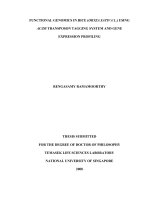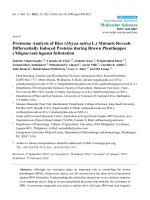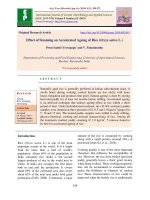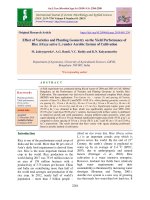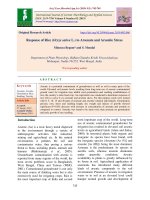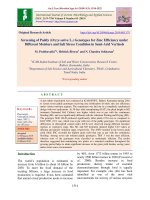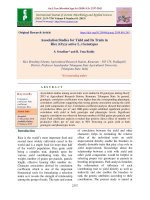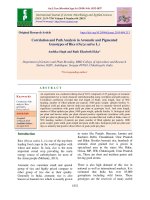Response of rice (Oryza sativa L.) to Arsenate and Arsenite stress
Bạn đang xem bản rút gọn của tài liệu. Xem và tải ngay bản đầy đủ của tài liệu tại đây (168.28 KB, 5 trang )
Int.J.Curr.Microbiol.App.Sci (2019) 8(2): 745-749
International Journal of Current Microbiology and Applied Sciences
ISSN: 2319-7706 Volume 8 Number 02 (2019)
Journal homepage:
Original Research Article
/>
Response of Rice (Oryza sativa L.) to Arsenate and Arsenite Stress
Minsura Begum* and S. Mondal
Department of Plant Physiology, Bidhan Chandra Krishi Viswavidyalaya,
Mohanpur, Nadia-741252, West Bengal, India
*Corresponding author
ABSTRACT
Keywords
Arsenate, Arsenite,
Germination, Rice,
Seedling, Toxicity
Article Info
Accepted:
07 January 2019
Available Online:
10 February 2019
Arsenic is a potential contaminant of groundwater as well as soil in many parts of the
world. Elevated soil arsenic levels resulting from long-term use of arsenic contaminated
ground water for irrigation may inhibit seed germination and seedling establishment of
rice, the country’s main food crop. An experiment was conducted to determine response of
rice (Oryza sativa L) to arsenate and arsenite stress. For this purpose seeds were treated
with 0, 5, 10, 15 and 20 ppm of arsenate and arsenite solution individually. Germination
percent, root, shoot and seedling length, dry weight and indices of growth showed
significant (P<0.05) decrease with increase in concentration of arsenate and arsenite as
compared to control. Arsenite was found to be more toxic than arsenate on germination
and early growth of rice seedling.
most important crop of the world. Long-term
use of arsenic contaminated groundwater for
irrigation has resulted in elevated soil arsenic
levels in agricultural lands (Alam and Sattar,
2000). In terrestrial plants, both organic and
inorganic As species have been found, with
the inorganic species (Arsenate [As (V)] and
arsenite [As (III)]) being the most dominant.
Arsenate is the predominant As species in
aerobic soils, whereas arsenite dominates
under
anaerobic
conditions.
Arsenic
availability to plants is greatly influenced by
its forms in soil. Agricultural application of
arsenicals has introduced many different
kinds of arsenic compounds to the soil
environment. Presence of arsenic in irrigation
water or in soil at an elevated level could
hamper normal growth and development of
Introduction
Arsenic (As) is a toxic heavy metal dispersed
in the environment through a variety of
anthropogenic activities like industrial,
mining and agricultural etc. In the natural
environment, it pollutes the soil and
contaminates water, thus posing a serious
threat to biota, including plants, animals and
humans (Mahimairaja et al., 2005).
Groundwater contamination with arsenic is
reported from many regions of the world, the
most severe problems occur in Bangladesh,
West Bengal, China and Taiwan (WHO,
2001). Contaminated groundwater is not only
the main source of drinking water but is also
extensively used for irrigating crops. Rice is
the most important crop of India and second
745
Int.J.Curr.Microbiol.App.Sci (2019) 8(2): 745-749
plants. Plants can develop toxicity symptoms
while they are exposed to excess arsenic
either in soil or in solution culture such as:
Inhibition of seed germination (Liebig, 1966);
decrease in plant height (CarbonellBarrachina et al., 1995); reduction in root
growth (Tang and Miller, 1991), wilting and
necrosis of leaf blades (Frans et al., 1988),
reduction in leaf area and photosynthesis
decrease in shoot growth (CarbonellBarrachina et al., 1998). Arsenite and arsenate
are inter convertible depending on the redox
condition of the soil (Masscheleyn et al.,
1991) with arsenite dominating in flooded
paddy soils.
Seeds with radical emergence equal to or
greater than two (2) mm were considered as
successful germination. Germination percent
of seeds were calculated for each treatment at
eighth day of incubation. On the eighth day,
seedlings were removed from petridishes and
length of shoot and root were measured
separately and mean values were determined.
Seedling vigor was calculated by multiplying
the germination % with total length (cm) of
the seedling (Woodstock 1969, Abdul-Baki
and Anderson 1973)
Results and Discussion
The germination response of the rice
genotype, Satabdi, to the treatments with
different concentrations and forms of arsenic
at each of 2nd, 4th, 6th and 8th day differed
significantly. Germination of rice seeds were
seriously affected by the presence of arsenic
in the nutrient solutions at the concentrations
of 5 ppm and above in arsenite treated seeds
and above 5 ppm in arsenate treatment.
Arsenite contaminated seeds showed no
germination at and beyond 15 ppm. The
percent germination over control decreased
significantly (p=0.05) with increasing
concentration of arsenite and arsenate and
germination was delayed by 1-2 days with
arsenic stress (Table 1). There is 1-2 fold
decrease in germination percent by arsenite
stress over arsenate. Complete inhibition in
germination observed above 10 ppm in
arsenite treated seeds. Lower germination of
rice seed at higher concentration of arsenite
than arsenate could be an important
consideration for wetland rice culture because
of presence of arsenite (Masscheleyn et al.,
1991 and Marin et al., 1993). The results of
decrease in germination under arsenic stress
are in agreement with the earlier observations
by Abedin and Meharg (2002).
We used both of these two inorganic species
in our study to see whether there is any
differential toxicity effect shown by the
arsenic species on rice cultivars. In this
present study, we evaluated response of rice
to arsenate and arsenite stress.
Materials and Methods
Seeds were surface sterilized with 0.1℅ (w/v)
Hgcl2 for two minutes, washed repeatedly
with glass distilled water and divided into
several batches of 20 seeds. Seeds were then
soaked separately in different arsenic solution
(5, 10, 15 and 20 ppm). Sodium arsenate
(Na2HAs3O4, 7H20) and arsenic oxide
(As2O3) were used for preparation of arsenate
(ASV) and arsenite (ASIII) solution. Ten (10)
ml of each solution was used to soak
Whatman No.1 filter paper in each of the
sterilized petridishes of 9 cm diameter, on
which the soaked seeds were spread at the
rate of 20 numbers per petridish for
germination. Control set was prepared
similarly using glass distilled water. All
petridishes were kept in the incubator
maintained at 28 ± 10C temperature. The
experiment was conducted in triplicate.
Germination counts were obtained at every
twenty four hours interval for eight days.
Significant decrease in root length, shoot
length, ratio of root and shoot length, seedling
746
Int.J.Curr.Microbiol.App.Sci (2019) 8(2): 745-749
length, dry weight and seedling vigor was
observed due to increase in arsenic
concentrations and arsenite was found to be
more toxic than arsenate in reducing seedling
growth. Shoot length and root length of the
seedlings were very seriously affected by the
presence of arsenic toxicants in the nutrient
solution. Even in the presence of 5 ppm
arsenate or arsenite in the nutrient solution the
total length of root and shoot was less than
40% of that of seedlings of untreated seeds.
The inhibitory effect was more pronounced
on root length than on shoot length. Reduced
shoot height due to application of arsenic in
this study also corroborates with the result of
Marin et al., (1992) who found significant
reduction of rice shoot height when arsenite
or mmAA was applied at a relatively lower
dose of 0.8mg As/l. The reduction of shoot
height due to arsenic exposure can be an
important consideration for rice cultivation as
reduced shoot height will decrease rice leaf
area, net photosynthesis (Marin et al., 1993),
and ultimately rice yield. Reduction of both
root and shoot length is a typical response to
toxic metals.
Reduced root length and shoot length growth
in response to arsenic exposure has been
reported by a number of investigators (Abedin
and Meharg, 2002 and Singh et al., 2007). It
is evident from table 2 that arsenic both as
arsenate and arsenite strongly inhibited dry
weight of the plant.
Table.1 Effect of arsenate and arsenite on germination percentage (%) of rice seeds at 2nd, 4th, 6th
and 8th days after treatment
Concentrations
(ppm)
Control
AS(V)
nd
2
91.67
86.67
-(5.46)
71.67
-(21.82)
61.67
-(32.73)
51.67
-(43.64)
28.33
-(69.09)
8.33
-(90.91)
0.00
-(100.00)
0.00
-(100.00)
52.22
1.44
0
5
10
15
20
AS(III)
5
10
15
20
44.45
Mean
S.Em (±)
For comparison
mean of
C.D (0.05)
4.33
747
Germination %
4th
6th
100.00
100.00
98.33
100.00
-(1.67)
(0.00)
78.33
81.67
-(21.67)
-(18.33)
68.33
71.67
-(31.67)
-(28.33)
55.00
55.00
-(45.00)
-(45.00)
51.67
61.67
-(48.33)
-(38.33)
18.33
20.00
-(81.67)
-(80.00)
0.000
0.00
-(100.00)
-(100.00)
0.00
0.00
-(100)
-(100)
54.45
55.74
3.73
2.39
11.18
7.18
8th
100.00
100.00
(0.00)
81.67
-(18.33)
71.67
-(28.33)
60.00
-(40.00)
68.33
-(31.67)
20.00
-(80.00)
0.00
-(100.00)
0.00
-(100)
44.45
2.28
6.84
Int.J.Curr.Microbiol.App.Sci (2019) 8(2): 745-749
Table.2 Effect of arsenate and arsenite on seedling length, root and shoot length ratio (cm),
seedling vigor and dry wt (mg/seedling) of rice seedling at 8 days after treatment
Concentrations
(mg l-1)
Control
AS(V)
Seedling
length (cm)
Root length/
shoot length
0
20.37
1.82
5
7.43
0.36
-(63.53)
-(80.22)
10
15
20
Seedling
vigor
2037
4.83
0.18
-(76.29)
-(90.11)
-(83.00)
0.25
-(86.27)
3.80
0.11
228.00
-(81.35)
-(93.96)
-(88.80)
5.67
0.32
387.43
-(72.17)
-(82.42)
-(80.98)
4.04
0.19
80.80
-(80.17)
-(89.56)
-(96.03)
15
0.00
0.00
20
0.00
0.00
5.89
21.21
63.59
0.38
1.16
3.10
5
10
AS(III)
For
comparison S.Em(±)
mean of
C.D(0.05)
The reduction in dry weight of plant materials
may be due to the poor functioning of
physiological processes related to growth in
presence of arsenic both as arsenate and
arsenite. These decrease in dry weight with
increase in arsenic concentration also reported
by Rahman et al., (2008).
7.00
743
-(63.53)
479.40
-(76.46)
346.17
5.87
-(71.18)
Dry wt.
(mg/seedling)
0.00
-(100.00)
0.00
-(100.00)
468.18
21.21
63.59
6.16
5.19
4.05
2.07
4.12
1.96
0.00
0.00
3.51
20.15
60.14
of glutamic acid and vigor of soybean
seeds. Crop Sci., 13: 227-232.
Abedin, M. J. and Meharg, A. A. (2002).
Relative toxicity of arsenite and
arsenate on germination and early
seedling growth of rice (Oryza sativa
L.). Plant Soil., 243: 57 – 66.
Alam, M. B. and Sattar, M. A. (2000).
Assessment of arsenic contamination in
soils and
waters in some areas of
Bangladesh. Water Sci. Tech. 42, 185–
193.Baker A J M 1987 Metal tolerance.
New Phytol. 106 (suppl.), 93–111.
Carbonell- Barrachina, A. A., Aarabi, M. A.,
DeLaune, R. D., Gambrell, R. P. and
Patrick, W. H. Jr. (1998). The influence
of arsenic chemical form and
concentration on Spartina patens and
So, from this investigation it can be
concluded that both arsenate and ardenite
reduces growth of rice seedling and ardenite
was found to be more toxic than arsenate in
decreasing germination and seedling growth.
References
Abdul-Baki, A. and Anderson, J. D. (1973).
Relationship between de-carboxylation
748
Int.J.Curr.Microbiol.App.Sci (2019) 8(2): 745-749
Spartina alterniflora growth and tissue
arsenic concentration. Plant Soil., 198:
33-43.
Carbonell-Barrachina, A., Burlo, C. F. and
Mataix, B. J. (1995). Arsenic uptake,
distribution, and accumulation in
tomato plants: effect of arsenic on plant
growth and yield. J. Plant Nutr.,
18:1237–1250.
Frans R, Horton D and Burdette L (1988).
Influence of MSMA on straighthead,
arsenic uptake and growth response in
rice (Oryza sativa). Arkansas AES. Rep.
Ser. 302, 1–12.
Liebig-Jr, G. P. (1966). Arsenic. In
Diagnostic Criteria for Plants and Soils.
Ed. H D Chapman. pp 13–23.
University of California, Division of
Agricultural Science, Riverside, CA.
Mahimairaja, S., Bolan, N.S., Adriano, D.C.,
Robinson,
B.
(2005).
Arsenic
contamination and its risk management
in complex environmental settings. Adv
Agron., 86:1–82.
Marin, A. R., Masscheleyn, P. H. and Patrick
W. H. Jr. (1992). The influence of
chemical form and concentration of
arsenic on rice growth and tissue arsenic
concentration. Plant Soil, 139: 175–183.
Marin, A. R., Pezeskhi, S.R., Masscheleyn,
P.H. and Choi, H. S. (1993). Effect of
dimethylarsenic acid (DMAA) on
growth,
tissue
arsenic,
and
photosynthesis of rice plants. J. Plant
Nutr., 16: 865–880.
Masscheleyn, P. H., Dlaune, R. D. and
Patrick, W. H. Jr. (1991). Effect of
redox potential and pH on arsenic
speciation and solubility in a
contaminated soil. Environ. Sci.
Technol., 25: 1414–1418.
Rahman, M. A., Hasegawa, H., Rahman, M.
M., Islam, M. N., Miah, M. A. M. and
Tasmen, A. (2007). Effect of arsenic on
photosynthesis, growth and yield of five
widely cultivated rice (Oryza sativa L.)
varieties in Bangladesh. Chemosphere.,
67: 1072-1079.
Singh, H. P., Batish, D. R., Kohli, R. K. and
Arora, K. (2007). Arsenic-induced root
growth inhibition in mung bean
(Phaseolus aureus Roxb.) is due to
oxidative stress resulting from enhanced
lipid peroxidation. Plant Growth Regul.,
53: 65 – 73.
Sreedevi,
S.,Krishnan,
P.N.
and
Pushpanngadan, P.(2008). Cadmium
induced oxidative damage
and
antioxidant responses in roots of black
gram [Vigna mungo (L.) hepper]. Indian
J. Plant Physiol., 1: 1-7.
Tang, T. and Miller, D. M. (1991). Growth
and tissue composition of rice grown in
soil treated with organic copper, nickel
and arsenic. Commun. Soil Sci. Plant
Anal., 22: 2037-2045.
Woodstock, L. W. (1969). Seedling vigor as a
measure of seed vigor. Int. Seed. Ass.,
34: 273-280.
WHO 2001 Arsenic in drinking water
URL: />en/fact210.h tml
How to cite this article:
Minsura Begum and Mondal, S. 2019. Response of Rice (Oryza sativa L.) to Arsenate and
Arsenite Stress. Int.J.Curr.Microbiol.App.Sci. 8(02): 745-749.
doi: />
749
